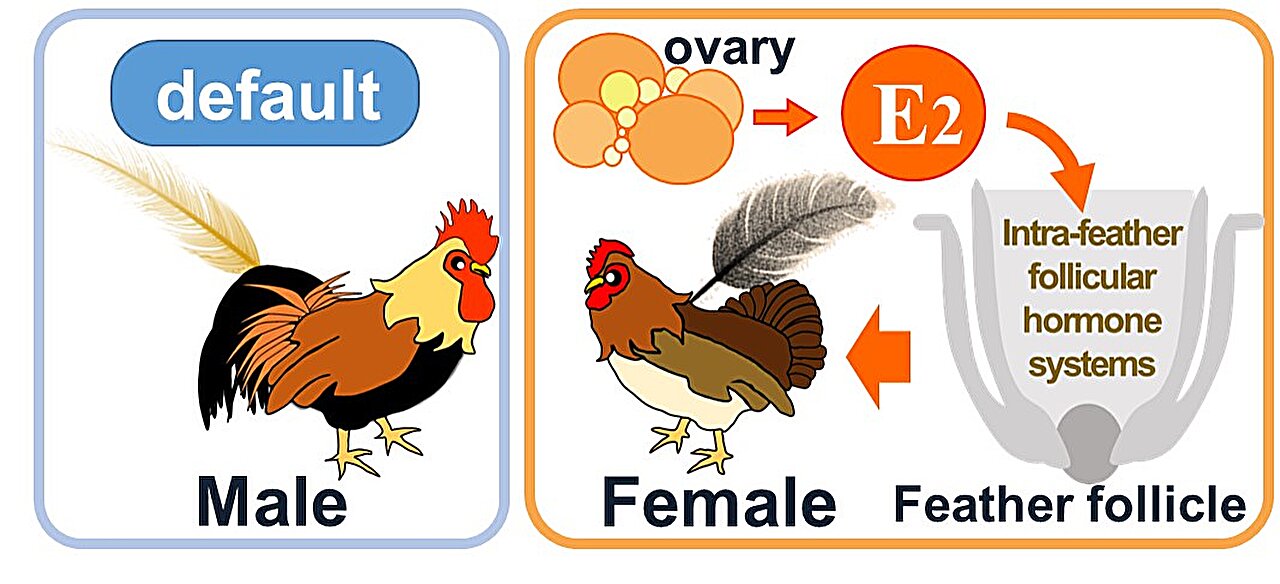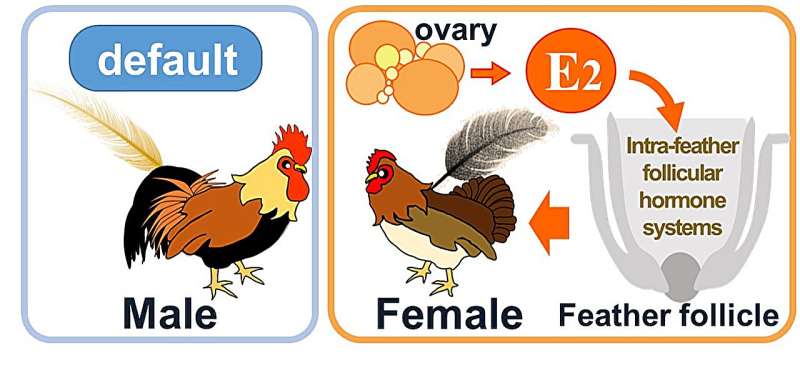

Birds possess unique skin appendages called feathers that are derived from the outermost layer of skin cells. Feathers are important for several functions, such as flight, temperature regulation, protection from external stimuli, and mating behavior. The gender-specific development of feathers in birds and the vibrant feather patterns that distinguish males from females, also known as sexual dimorphism, have piqued the interests of the global research community.
Previous scientific reports have implicated the role of estrogen and thyroid hormones in the formation of feathers. However, the underlying molecular mechanisms and relationship between the two hormones remain unknown. In order to shed light on the hormonal interplay underlying sexual dimorphism of chicken feathers, a team of researchers from Japan has now conducted a series of advanced, innovative genetic expression experiments.
The research team was led by Professor Sakae Takeuchi from the Graduate School of Environmental, Life, Natural Science and Technology, Okayama University, Japan and ably assisted by Hibiki Fukuchi, a Ph.D. student at the Graduate School of Environmental, life, Natural Science and Technology, Okayama University, Japan. Their findings were published in General and Comparative Endocrinology on 1 October 2024.
Talking about the motivation behind this study, Prof. Takeuchi says, “Melanocyte-stimulating hormone (MSH), secreted by the intermediate lobe of the pituitary gland, regulates body color in most vertebrates. However, birds are believed to be lacking MSH due to the absence of the intermediate lobe. Our research team has documented and shown that birds produce and utilize MSH to regulate the development of feathers.”
Initially, the researchers administered estrogen (E2) capsules to male chickens, which induced the formation of female-type feathers in E2-treated males, with the distinct presence of barbules. Furthermore, they investigated the role of the thyroid hormone activation/inactivation system in the sexual dimorphism seen in saddle feathers.
To this end, Takeuchi and his colleagues utilized RT-PCR analysis to study the expression of specific genes, such as DIO2 (type 2 deiodinase)—a thyroid hormone activator, and DIO3 (type 3 deiodinase)—a thyroid hormone inactivator from the RNA (ribonucleic acid) of regenerated feather follicles. Additionally, the expression of BlSK1 (barbule specific keratin 1), a barbule-specific marker, and ASIP (agouti signaling protein), a red/yellow melanin inducer, were also observed.
The results indicated that E2 treatment repressed the expression of DIO3 and ASIP, while stimulating the expression of BlSK1, thus affecting the overall fringe structure and coloration of feathers. Finally, the researchers assessed the effects of thyroid on sexual dimorphism via the administration of thyroxine (T4) and triiodothyronine (T3).
They found that T4 administration in chickens increased the expression of BlSK1 and POMC (proopiomelanocortin), a precursor of MSH, which induces black/brown melanin, resulting in solid black feathers. Treatment of cultured pulp cells (isolated from wing feathers) with T3 resulted in increased expression of POMC.
Prof. Takeuchi says, “By understanding sexual dimorphism and sex differences that are driven by hormones, we have not only made an attempt to enhance our grasp of biological diversity, but also to contribute to a society that is more inclusive and accepting of sexual and gender minorities.” Needless to say, this understanding fosters empathy and promotes social cohesion, benefiting the society at large by encouraging greater tolerance and understanding of diversity.
In summary, these findings reveal the hormone-dependent molecular mechanisms that cause sexual dimorphism in chicken feathers, besides highlighting the cultural significance attached to chickens in Japanese society since ancient times.
More information:
Li You et al, Revisiting the hormonal control of sexual dimorphism in chicken feathers, General and Comparative Endocrinology (2024). DOI: 10.1016/j.ygcen.2024.114601
Provided by
Okayama University
Citation:
Research provides molecular insights into sexual dimorphism of chicken feathers (2024, October 18)
retrieved 18 October 2024
from https://phys.org/news/2024-10-molecular-insights-sexual-dimorphism-chicken.html
This document is subject to copyright. Apart from any fair dealing for the purpose of private study or research, no
part may be reproduced without the written permission. The content is provided for information purposes only.